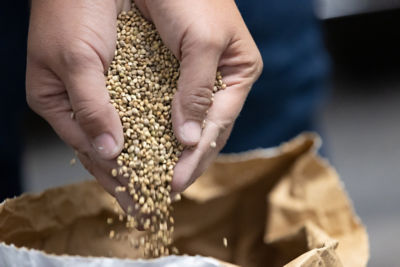Click here to download a PDF version of this spotlight
» Degree days can be used as a measurement of physiological time to predict the rate of development of cold-blooded organisms.
» Degree day accumulations can be used to predict certain developmental stages of arthropod pests of vegetable crops.
» Degree day models can help growers more accurately time the use of pest management strategies.
WHAT ARE DEGREE DAYS?
The rates of development of plants and cold-blooded animals (including insects) are strongly influenced by temperature. These organisms tend to develop more rapidly at warmer temperatures and more slowly when temperatures are cooler. The response to temperature allows the rate of development of these organisms to be predicted based on heat accumulation over time, often expressed as degree days.1,2,3
Degree days are calculated from temperatures between the lower and upper temperatures thresholds of the organism over a 24-hour period. One degree day (DD) represents one 24-hour day with a temperature one degree above the lower threshold for physiological development. For example, if the lower threshold for development is 51°F, a steady temperature of 52°F for 24 hours would result in the accumulation of one DD. With a steady temperature of 52°F for 24 hours, two DD would accumulate.1
Because the amount of heat needed for an organism to reach a developmental stage is constant, the accumulation of degree days from a certain starting point can be used to predict events such as egg- laying, egg hatch, or the emergence of adult insects from pupae. This information can be used to more effectively schedule management efforts, such as scouting or the application of insecticides.3 Degree days often accumulate slowly at the beginning of the season and more rapidly as daily temperatures increase.4 For pest management purposes, degree day calculations are used mostly to predict the development of insect/arthropod pests.
THRESHOLDS AND STARTING POINTS
The minimum temperature needed for physiological development is often referred to as the lower temperature threshold. The temperature above which the rate of growth begins to decrease is called the upper threshold or the cutoff temperature. Most insect pests of plants have an upper threshold (or cutoff) between 100° and 110°F (38° to 43°C). Most soil-dwelling insects have lower thresholds between 41° to 45°F (5° to 7°C), and most insects that live above ground have lower thresholds around 50°F (10°C).1,2
The starting point for beginning to accumulate degree days can be a calendar date, such as January 1 for spring-planted crops in the northern hemisphere. A disadvantage of using a date like this is that the date may be well before any insect development occurs, resulting in less accurate predictions. An alternative to using a calendar date is to use a biofix date as the starting point. A biofix date is based on a specific biological event, such as the first capture of an adult insect in a geographical area. The use of biofix dates usually results in a shorter period over which degree days need to be calculated and more accurate predictions of physiological events.3
CALCULATING DEGREE DAYS
While the concept of a degree day is fairly simple (a temperature of one degree above the lower threshold for 24 hours), in reality, temperatures fluctuate throughout the day. Therefore, calculating degree day accumulations is complicated, and several methods have been developed to accomplish the task. Some methods use daily minimum and maximum temperatures to estimate degree day totals for a 24-hour period (Figure 1). Other methods use periodic (often hourly) temperature readings throughout the day to estimate degree day accumulations.1 When using degree days to help schedule pest management efforts, it is important to use the same method of calculating degree days that was used to develop the pest degree day model and associated guidelines.
 Figure 1. For the single sine method of calculating degree days, a symmetrical sine curve is drawn between the daily minimum and maximum temperatures. The area under the curve is used to calculate the degree day accumulation.
Figure 1. For the single sine method of calculating degree days, a symmetrical sine curve is drawn between the daily minimum and maximum temperatures. The area under the curve is used to calculate the degree day accumulation.
A simple way to calculate degree days is the minimum/maximum temperature method. With this method, the daily minimum temperature and maximum temperature are added together. That total is divided by two, and the base temperature for the model is subtracted from the total to estimate the number of degree days accumulated. For example, if the minimum temperature for the day was 45°F, the maximum temperature was 75°F, and the base temperature for the model is 50°F, the accumulation estimate would be 10 degree days: (45+75)/2-50 = 10.3 More complicated methods that provide increased accuracy include the single triangle, double triangle, single sine, and double sine methods.1 The single sine method is commonly used in a number of available insect pest degree day models (Figure 1).
These models can be modified by taking the upper threshold (cutoff) temperature into account. Again, several methods are used to include the cutoff temperature in degree day models (Figure 2). With the horizontal cutoff method, it is assumed that the rate of development will not increase with temperature, so the area of the temperature curve above the maximum threshold is not counted in the degree day calculation, as if the temperature remained at the maximum threshold during that period. With the intermediate cutoff method, it is assumed that the rate of development of the organism will slow but not stop, and the area above the cut off is subtracted from the total area. With the vertical cutoff method, it is assumed that all development stops, and no degree days are added to the DD total during that period.1
 Figure 2. Cutoff methods are used to adjust degree day calculations when temperatures exceed the upper threshold.
Figure 2. Cutoff methods are used to adjust degree day calculations when temperatures exceed the upper threshold.
Degree day targets for specific pests are determined using growth chamber studies, field studies, and experienced trial and error efforts that are refined over time.2 Models can be adapted between Celsius and Fahrenheit scales with the 5/9 conversion (one-degree change in Fahrenheit is equal to a 5/9 degree change in Celsius.4 The tomato fruitworm model provided on the University of California Integrated Pest Management site is a single sine, horizontal cutoff model that uses a lower threshold of 55°F and an upper threshold of 92°F. The biofix date is the date that fruitworm eggs are first detected during the month of July. The model is used to predict the egg-laying generation in August that can attack tomato fruit. The fruitworm needs 968 DD (°F) to complete a generation.5
A DD model for the western bean cutworm was developed in Nebraska. This simple DD model uses a start date of March 1, a lower threshold of 38°F, and an upper threshold of 75°F. When 2,577 DD have accumulated, approximately 25% of the moth flights have completed, and it is time to start scouting to estimate egg densities.6 A DD model for the European corn borer (ECB) was developed
at the University of Kentucky.7 This is a simple DD model with a lower threshold of 50°F, an upper threshold of 85°F, and a start date of January 1. The model can be used to predict adult emergence, egg laying, and egg hatch for first and second generations of ECB. A table on the university website indicates the DD accumulation values associated with the various developmental stages of the insect.
Degree day prediction models are available for vegetable pests in many states. The sites often allow the user to select the target pest and geographic location (by county or weather station). Some sites provide the grower with a table of DD accumulation values, while others allow the grower to input information, such as the biofix date, in an online calculator. These models can help the grower estimate when scouting efforts will need to intensify and when treatments will be needed for pest management. 5,6,7,8,9,10
SOURCES
1 UC IPM. 2016. How to Manage Pests: Degree days. http://ipm.ucanr.edu/WEATHER/ddconcepts.html.
2 Shetlar, D. and Hale, F. 2008. Degree days in pest management. Bugwoodwiki. https://wiki.bugwood.org/Degree_days_in_pest_management.
3 Bessin, R. and Villanueva, R. 2019. Predicting insect development using insect degree days.
University of Kentucky, Enftact-123.
4 Adams, N. Using growing degree days for insect management. University of New Hampshire
Cooperative Extension.
5 UC IPM. Weather, models, & degree days. http://ipm.ucanr.edu/WEATHER/index.html#PESTPLANTMODELS.
6 Peterson, J., Westen, A., Bradshaw, J., Montezano, D., and Wright, R. 2015. Using DegreeDays to Predict Western Bean Cutworm Flight Times. https://cropwatch.unl.edu/using-degree-days-predict-western-bean-cutworm-flight-times.
7 Bessin, R. 2019. Predicting European Corn Borer Development. University of Kentucky
ENTFACT-106. https://entomology.ca.uky.edu/ef106.
8 Illinois Climate Network: Daily pest degree-day accumulations.
https://www.isws.illinois.edu/warm/pestdata/.
9 Oregon State University, Oregon IPM Center. https://uspest.org/wea/weaexp.html. 10 Degree day calculator. UW Extension Ag Weather. https://agweather.cals.wisc.edu/thermal_models/degree_days.
Websites verified 4/23/2021
ADDITIONAL INFORMATION
For additional agronomic information, please contact your local seed representative.
Performance may vary from location to location and from year to year, as local growing, soil and weather conditions may vary. Growers should evaluate data from multiple locations and years whenever possible and should consider the impacts of these conditions on the grower’s fields. The recommendations in this article are based upon information obtained from the cited sources and should be used as a quick reference for information about vegetable production. The content of this article should not be substituted for the professional opinion of a producer, grower, agronomist, pathologist and similar professional dealing with vegetable crops.
BAYER GROUP DOES NOT WARRANT THE ACCURACY OF ANY INFORMATION OR TECHNICAL ADVICE PROVIDED HEREIN AND DISCLAIMS ALL LIABILITY FOR ANY CLAIM INVOLVING SUCH INFORMATION OR ADVICE.
9050_SE_S11 Published 05/17/2021
Bayer, Bayer Cross Design, and Seminis® are registered trademarks of Bayer Group. All other trademarks are property of their respective owners. © 2021 Bayer Group. All rights reserved.



